Creating a suitable leopard gecko tank setup involves setting up a tank with care. Providing a warm, safe, and comfortable environment is the key point. You’ll need to place a heat source, such as an under-tank heater, to maintain the right temperature. A hideout and a shallow dish for water are also essential.
What should be the size of a leopard gecko tank? The appropriate size for a leopard gecko tank is significant. A tank that’s at least 10 gallons is a good starting point, but as your gecko grows, a 20-gallon tank becomes preferable. This allows ample space for movement, hiding spots, and climbing.

- Importance Of A Proper Leopard Gecko Tank Setup
- Choosing The Right Tank Size For Your Leopard Gecko
- What Do Leopard Geckos Need In Their Tank? : Leopard Gecko Habitat Accessories
- The Importance Of Providing Proper Temperature Gradient In The Tank
- Lighting Requirements For Leopard Geckos
- Substrate Options For The Tank And Their Pros And Cons
- Creating A Comfortable And Stimulating Environment With Hiding Place For Your Leopard Gecko
- Supplementing The Tank With Appropriate Decorations And Enrichment Items: Plants For Leopard Geckos Habitat
- Feeding And Watering Considerations For Your Leopard Gecko’s Tank
- Maintaining Proper Humidity Levels In The Tank
- Cleaning And Maintaining The Leopard Gecko’s Tank On A Regular Basis
- Common Mistakes To Avoid When Setting Up A Leopard Gecko Tank
- FAQ About Leopard Gecko’s Tank Setup
- Final Thought
Importance Of A Proper Leopard Gecko Tank Setup
The right environment mimics their natural habitat, ensuring comfort and reducing stress. A suitable tank size with hiding spots, climbing opportunities, and a temperature gradient promotes physical and mental health.
Adequate substrate and a shallow water dish are essential. Well-maintained tanks prevent health issues, encourage natural behaviors, and foster a content leopard gecko care.
Leopard Gecko Tank Accessories
Leopard gecko tank accessories play a vital role in creating a comfortable and stimulating environment for your pet store. Items like hiding shelters, branches, and rocks offer places to explore and rest.
A temperature-regulating mat keeps the tank warm, while a shallow water bowl provides hydration. These simple yet essential elements encourage natural behaviors.
Choosing The Right Tank Size For Your Leopard Gecko
Selecting the appropriate tank size is crucial when caring for a leopard gecko. A tank that’s too small can restrict their movement and lead to stress.
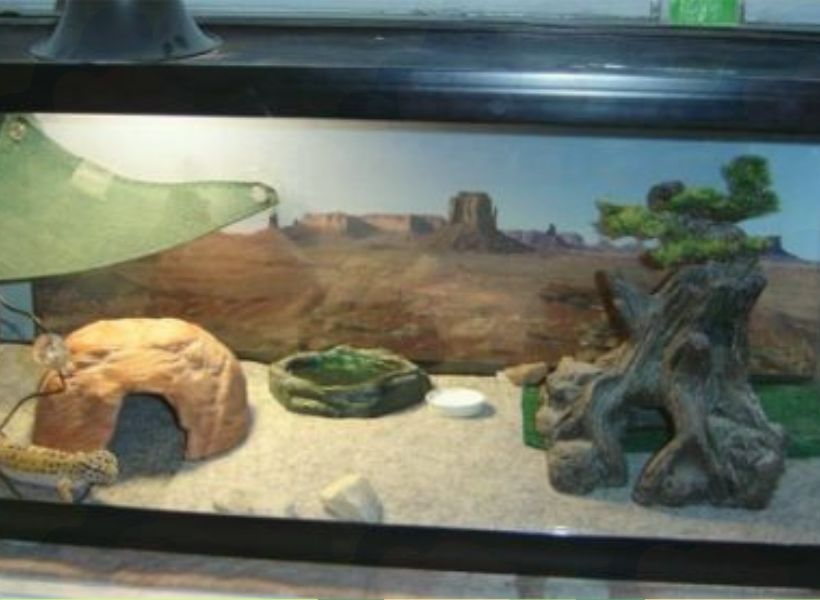
Aim for a 10 gallon tank at the very least, but a 20-gallon one is preferable as it provides more space for activity.
A well-sized tank ensures your gecko’s comfort, allows for hiding spots, and promotes a healthier, happier life for your reptile companion.
Best Leopard Gecko Tank Size
The best tank size for a leopard gecko is around 20 gallons and the minimum size for single leopard gecko is 10-gallon tank.
This size offers ample space for them to move, hide, and explore comfortably. A larger tank promotes their comfort, encourages natural behaviors, and allows for a variety of enriching accessories.
Providing the right tank size contributes to content and thriving leopard gecko.
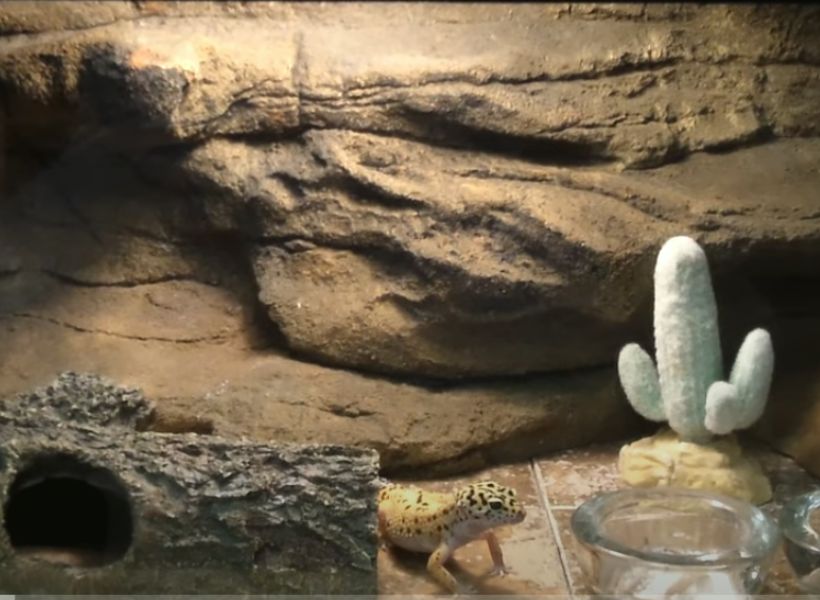
What Do Leopard Geckos Need In Their Tank? : Leopard Gecko Habitat Accessories
Leopard gecko mainly needs in their tank like, a heat source for proper temperature, hiding spots, a substrate for the floor, a shallow water dish, and some climbing opportunities for gecko to climb.
These essentials create a comfortable and engaging environment that mimics their natural habitat, ensuring your gecko’s comfort.
For setting up a leopard gecko tank requires these few key items. The suitable tank size will be around 20 gallons.
Leopard Gecko Setup Kit
A leopard gecko setup kit provides everything you need for your pet’s ideal habitat enclosure.
It includes a spacious tank, temperature-regulating equipment, cozy hiding shelters, a substrate, a water dish, and climbing accessories. This convenient kit ensures a comfortable and stimulating environment.
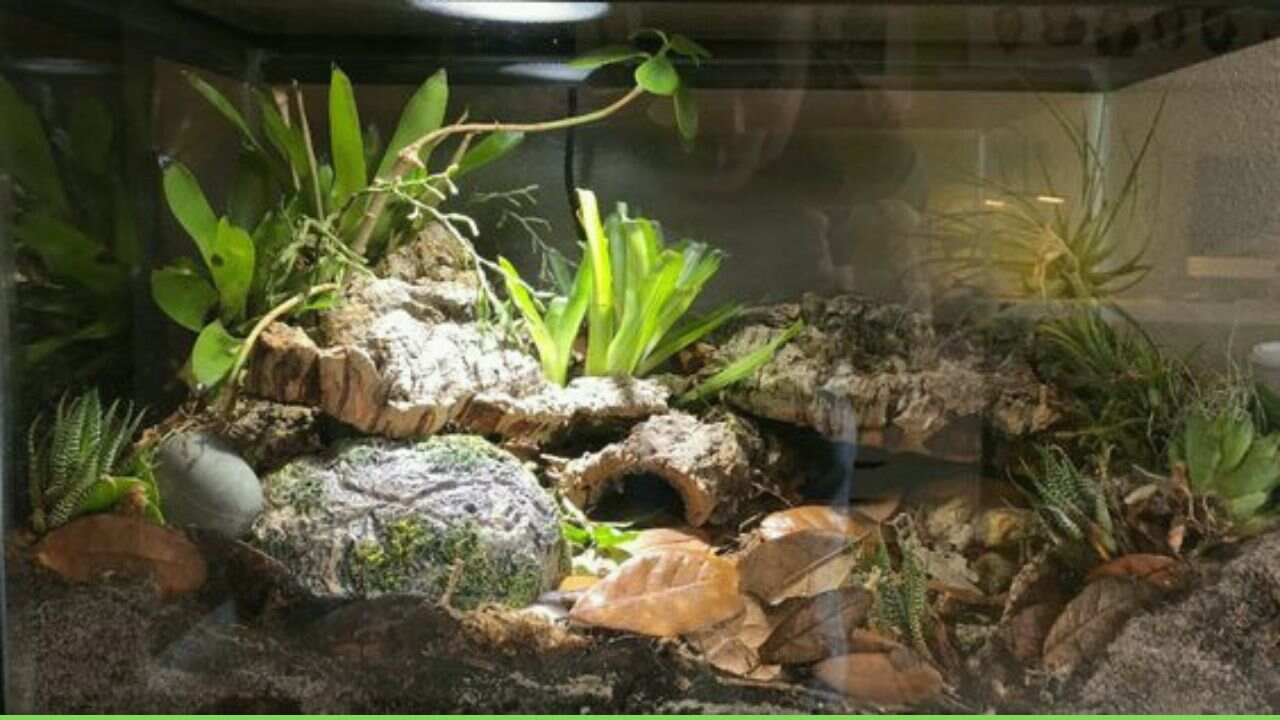
The Importance Of Providing Proper Temperature Gradient In The Tank
Supplying the right temperature gradient within the tank humidity is vital for your leopard gecko’s happiness. This means having a warmer area on one side of the tank and a cooler zone on the other.
This setup allows your gecko to regulate its body temperature effectively, promoting digestion, activity, and overall health.
A proper temperature gradient ensures that your leopard gecko can flourish and show natural behaviors in a comfortable and stress-free environment.
Lighting Requirements For Leopard Geckos
Leopard geckos require appropriate lighting for their tank. During the day, they flourish with natural light or a low-wattage bulb, and at night, a soft red or blue bulb helps simulate their nocturnal environment.
A heat lamp is useful for lighing set up that provide both heat and light during daytime hours.
A consistent light-dark cycle supports their natural rhythms and behaviors, contributing to their overall comfort and making for a happy and healthy gecko.
Substrate Options For The Tank And Their Pros And Cons
Choosing the right substrate for your leopard gecko tank involves considering various options. Paper towels and reptile carpets are easy to clean but may lack a natural feel.
Loose substrates like coconut fiber or calcium sand mimic their habitat but can pose ingestion risks. Tile or slate provides a solid surface but may not satisfy digging instincts.
Weigh the pros and cons to create safe and comfortable flooring that suits your gecko’s needs.

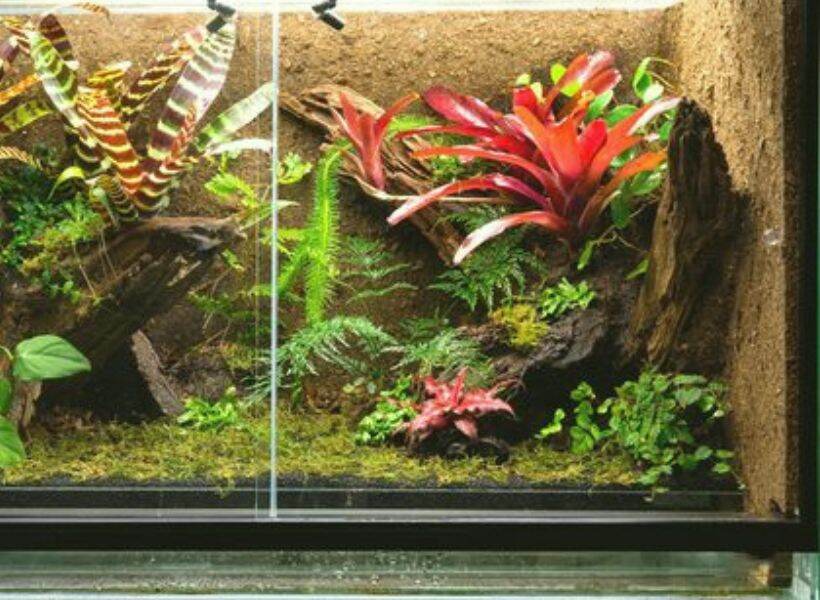
Creating A Comfortable And Stimulating Environment With Hiding Place For Your Leopard Gecko
Crafting a cozy and engaging atmosphere for your leopard gecko involves incorporating hiding spots into their habitat. These shelters, like caves or logs, offer a sense of security while encouraging natural behaviors.
Leopard gecko tank setup properly give your gecko will feel safer, reduce stress, and have opportunities for exploration.
A well-designed environment with proper hiding places ensures content and mentally stimulated leopard geckos, contributing to their health and happiness.

Supplementing The Tank With Appropriate Decorations And Enrichment Items: Plants For Leopard Geckos Habitat
Enhance your leopard gecko’s tank by adding suitable decorations and enrichment items. Branches, rocks, and artificial plants provide climbing and hiding opportunities, mirroring their natural habitat.
Such additions stimulate physical activity and mental engagement. Just ensure the decorations are secure and non-toxic.
These enhancements make the tank more than a habitat – a space where your gecko can flourish, express natural behaviors, and lead a fulfilling reptile life.
Feeding And Watering Considerations For Your Leopard Gecko’s Tank
Feeding and watering your leopard gecko in its tank require attention. Provide a shallow dish of clean, fresh water to ensure hydration. Dust their insect meals with a calcium supplement for proper nutrition.
Schedule regular feeding times to maintain a healthy routine. Keep an eye on their eating habits and adjust portion sizes as needed.
Maintaining Proper Humidity Levels In The Tank
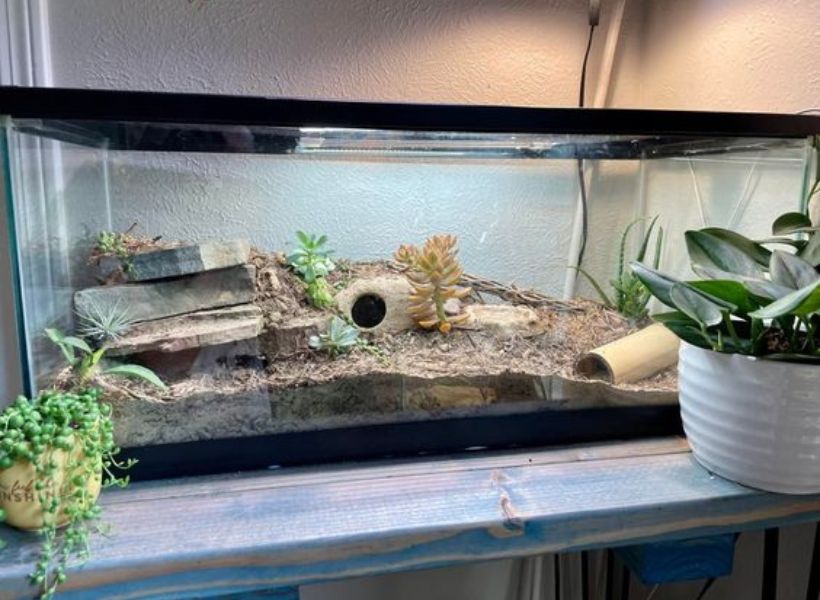
Maintaining the right humidity levels within your leopard gecko’s tank is key. Aim for a humidity range of 30% to 40%, which imitates their native arid environment. Achieving this helps with shedding and respiratory health.
You can mist the tank lightly, focus on proper ventilation, and use a hygrometer to monitor levels. By upholding the appropriate humidity, you create a comfortable space for your gecko’s comfort.
Cleaning And Maintaining The Leopard Gecko’s Tank On A Regular Basis
Regularly cleaning and maintaining your leopard gecko’s tank is essential for their health and happiness. Remove uneaten food, clean the water dish, and spot-clean waste to prevent bacterial growth.
Every few weeks, replace the substrate and clean all tank surfaces with a pet-safe cleaner. This routine upkeep prevents odors and maintains a hygienic environment.

Common Mistakes To Avoid When Setting Up A Leopard Gecko Tank
When establishing a leopard gecko tank, steer clear of common errors for your pet’s comfort. Avoid using heat rocks, which can harm them. Don’t choose substrates like loose sand that might be ingested.
Stay away from overcrowding and ensure proper ventilation. Don’t skip the temperature gradient setup or neglect hiding spots.
By sidestepping these mistakes, you provide a secure and pleasant habitat that supports your leopard geckos.
FAQ About Leopard Gecko’s Tank Setup
What Do I Need To Setup A Leopard Gecko Tank?
To set up a leopard gecko tank, Leopard gecko owners will need essentials like a spacious tank (around 20 gallons), proper heating for temperature control, hiding spots, a substrate for the floor, a shallow water dish, and climbing elements. These components combine to create a comfortable and engaging perfect leopard gecko habitat, ensuring your gecko’s well-being and happiness.
What Does An Ideal Leopard Gecko Tank Look Like?
An ideal leopard gecko tank is spacious, around 20 gallons, with regulated heating for warmth. It contains hiding spots, moist hide, climbing accessories, and a shallow water bowl. The substrate provides comfort, and lighting mimics their natural cycle. This setup creates a secure, stimulating home, fostering your gecko’s health, natural behaviors, and overall contentment.
What Not To Put In A Leopard Gecko Tank?
Avoid placing heat rocks in your leopard gecko tank, as they can lead to burns. Also, steer clear of loose substrates like sand, which may be ingested and cause health issues. Opt for safe decorations and avoid overcrowding to ensure a secure and comfortable environment for your gecko’s well-being.
How Big Of A Tank Do You Need For One Leopard Gecko?
For one leopard gecko, a tank of around 20 gallons is recommended. This size offers enough room for movement, hiding spots, and enrichment. It ensures your gecko’s comfort, promotes natural behaviors and contributes to a healthier and happier reptile companion.
Final Thought
When you consider about leopard gecko tank setup, pay attention to factors like tank size, temperature, lighting, and suitable decorations.
Providing hiding spots, proper substrate for leopard geckos, and a well-balanced diet are equally important.
Regular cleaning and monitoring ensure their health. By addressing these aspects thoughtfully, you cultivate a fulfilling life for your leopard gecko and establish a rewarding companionship built on care and understanding.


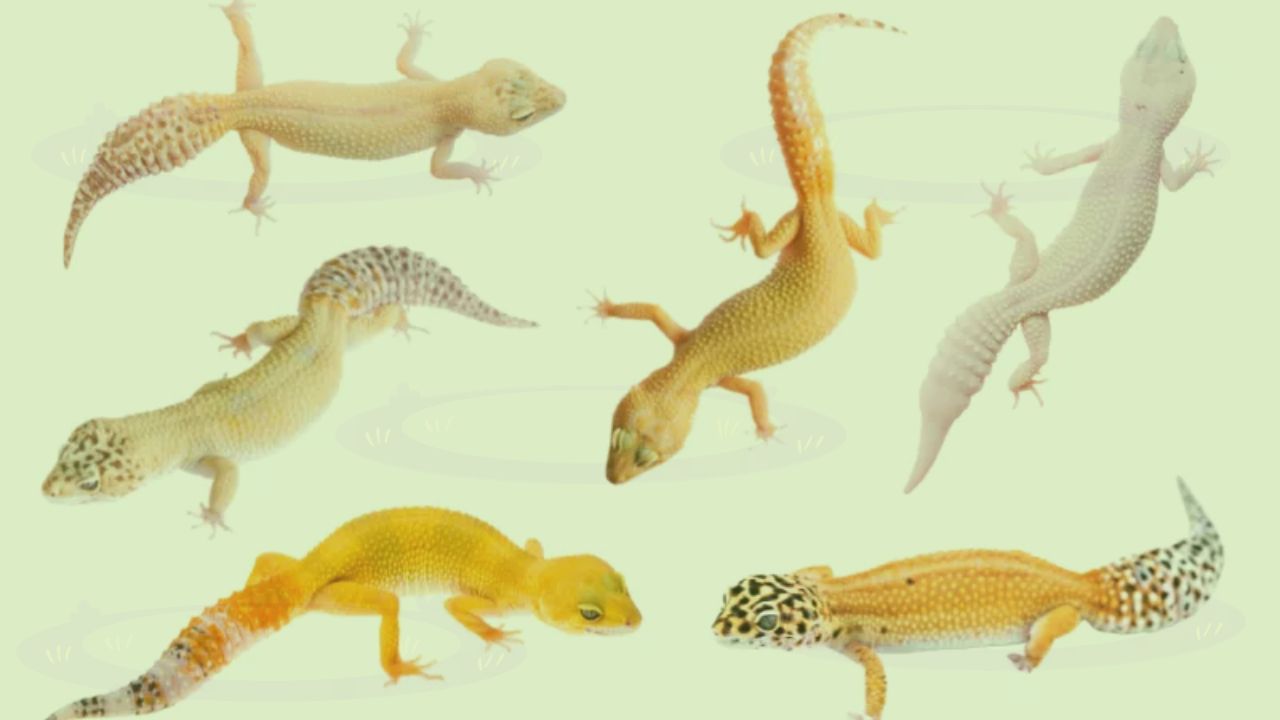

Leave a Reply